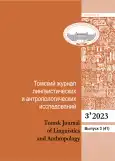No 3 (2023)
LINGUISTICS
Verbs Derived From Adjectives: Telicity and Event Structure
Abstract
 9-21
9-21


The Image of a Woman in the Russian, Tatar and Khanty Phraseological Pictures of the World
Abstract
 22-34
22-34


Verbs of Falling in the Tatyshly Udmurt Language
Abstract
 35-46
35-46


About the Pragmatic Features of the Mythological Prose of Altai
Abstract
 47-56
47-56


The Names of Large Domestic Animals in the Mongolian Languages in Comparison with the Bashkir Language and the Language of the Siberian Tatars
Abstract
 57-70
57-70


Ablatives in Nanaic Languages
Abstract
The article deals with the markers expressing ablative semantics in Nanaic varieties, including several Nanai dialects (Naikhin, Dzhuen, Gorin, and Bikin), Ulcha, Uilta, and Kili (Kur-Urmi). The study compiled a list of contexts with ablative and closely related semantics and analyzed which grammatical element is used in each context in each language variety. The study draws on textual data from a variety of sources, including our own field recordings, archival texts, and published texts. The final dataset shows several clusters of language varieties, meanings, and ablative markers. There are three clusters of Nanaic varieties based on the attested ablative cases: Naikhin and Dzhuen Nanai, Gorin Nanai and Uilta, and a random cluster of Bikin Nanai and Ulcha. The Kili variant stands out from these. The observed ablative markers cluster according to the meaning groups they cover: proper ablative markers, the ablative/instrumental marker -ǯi, prolative case markers -ki and -kki, which cover a near-prolative subset of the ablative domain, and a broader locative/prolative marker -la, which combines nearprolative meanings and sources of information or transmission. The Nanaic varieties show three stable polysemy patterns: ablative core meanings, near-prolative meanings, and physical and metaphorical transfer. Finally, there are two clusters based on the distribution of markers within the ablative domain: The first cluster includes Naikhin Nanai, Dzhuen Nanai, Kili, and possibly Bikin Nanai, while the second cluster includes Uilta and Ulcha. Gorin Nanai stands apart.
 71-89
71-89


ANTHROPOLOGY
Between the Vakh and Taz River: On the Origin of the of Northern Selkups
Abstract
 90-101
90-101


Personal Names of the Peoples of Bashkortostan: General Patterns of Development of the Names of Creativity and the Uniqueness of Cultures
Abstract
 102-109
102-109


The Perspective of Interpreting Cultural Values Based on Folklore (Using The Example of Ethnic Groups in Kenya and Neighboring Regions)
Abstract
 110-118
110-118


The Inhabitants of the Tomsk Monastery of St. John the Baptist (1869–1917): The Experience of Prosopographical Research
Abstract
 119-130
119-130


About the Results of a Trip to the Selkup Porg at the Parusovye Lakes
Abstract
 131-139
131-139


Snow in the Yakut Habitat: Traditions and Modernity
Abstract
 140-153
140-153


About the Stages of a Person's Life in the Tradition of Age Counting Among the Altaians
Abstract
 154-164
154-164


REVIEWS
 165-171
165-171











